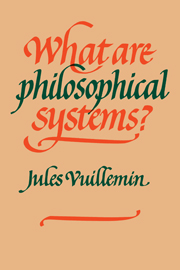1 - PERCEPTUAL ORGANIZATION
Published online by Cambridge University Press: 04 August 2010
Summary
THE MAIN OBJECT OF THE CHAPTER
The largest part of the present chapter deals with the question: what are the experienced relations which organize perception, and how do they expand so that in agreement with the evolution of the higher central nervous system they culminate both in simulating life-surroundings and in planning actions? The principles of organization will be shown to apply to the data so as to produce appearances of a given kind, and then to reapply to these appearances so as to yield appearances of yet another kind, until, no further innovation being yielded in this way, the process is put to an end and perceptual organization is considered complete. The diverse kinds of appearances that will be thus distinguished (qualities of position and of state, images and representations) are biologically useful only because they are given an objective interpretation. This description is then followed by two discussions. The first is about the kind of symbolic forms that span perceptual organization: have we to accept the claim of these forms to objectivity or must we rather interpret them in terms of subjective signals? The second discussion will concern what is wanting in perceptual organization for making group communication possible.
Though the following description of perceptual organization is systematic, it only aims at sketching the phenomenology of sensible appearances. It must be distinguished from psycho-physiology as well as from developmental psychology and philosophical constitution.
- Type
- Chapter
- Information
- What Are Philosophical Systems? , pp. 1 - 35Publisher: Cambridge University PressPrint publication year: 1986



